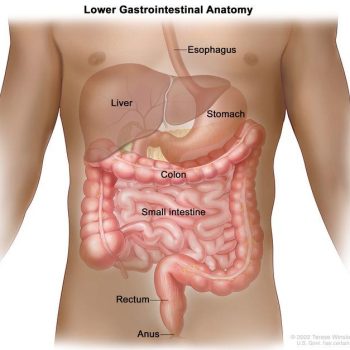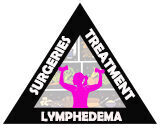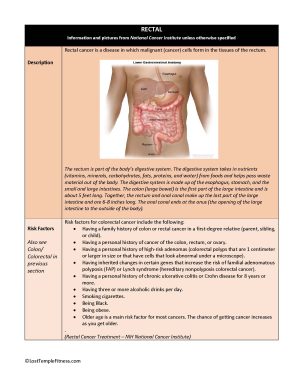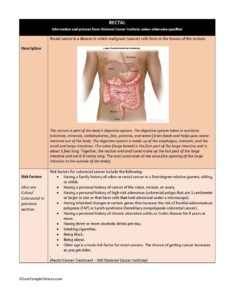Rectal Cancer
Your Body is Your Temple
Research, Resources & Education
Table of Contents
Rectal cancer is a cancer that forms in the rectum, between the colon and anus. It can be caused by genetics, environment, poor diet, or inflammation. Symptoms vary but may include abdominal pain, rectal bleeding, and weight loss.
Information and pictures from National Cancer Institute unless otherwise specified
Also refer to COLON CANCER page
Rectal Anatomy

- The rectum is part of the body’s digestive system.
- The digestive system takes in nutrients (vitamins, minerals, carbohydrates, fats, proteins, and water) from foods and helps pass waste material out of the body.
- The digestive system is made up of the esophagus, stomach, and the small and large intestines.
- The colon (large bowel) is the first part of the large intestine and is about 5 feet long.
- Together, the rectum and anal canal make up the last part of the large intestine and are 6-8 inches long.
- The anal canal ends at the anus (the opening of the large intestine to the outside of the body).
Rectal / Colorectal Cancer Videos
YouTube Videos that help explain Rectal / Colorectal Cancer.
Disclaimer:
This is for research only and Lost Temple Fitness & Cancer does not endorse any video presented on this website.
It is advised that you ALWAYS CHECK WITH YOUR PHYSICIAN for a proper diagnosis and treatment plan.
Rectal / Colorectal Cancer
Treatments
Also see Treatments
Surgery is the most common treatment for all stages of rectal cancer. The cancer is removed using one of the following types of surgery:
If the cancer is found in a polyp (a small piece of bulging tissue), the polyp is often removed during a colonoscopy.
If the cancer is found on the inside surface of the rectum and has not spread into the wall of the rectum, the cancer and a small amount of surrounding healthy tissue is removed.
If the cancer has spread into the wall of the rectum, the section of the rectum with cancer and nearby healthy tissue is removed.
- Sometimes the tissue between the rectum and the abdominal wall is also removed.
- The lymph nodes near the rectum are removed and checked under a microscope for signs of cancer.
The use of a special probe with tiny electrodes that kill cancer cells.
- Sometimes the probe is inserted directly through the skin and only local anesthesia is needed.
- In other cases, the probe is inserted through an incision in the abdomen.
- This is done in the hospital with general anesthesia.
A treatment that uses an instrument to freeze and destroy abnormal tissue.
This type of treatment is also called cryotherapy.
If the cancer has spread to other organs near the rectum, the lower colon, rectum, and bladder are removed.
- In women, the cervix, vagina, ovaries, and nearby lymph nodes may be removed.
- In men, the prostate may be removed.
- Artificial openings (stoma) are made for urine and stool to flow from the body to a collection bag.
After the cancer is removed, the surgeon will either:
- Do an anastomosis (sew the healthy parts of the rectum together, sew the remaining rectum to the colon, or sew the colon to the anus)
- Make a stoma (an opening) from the rectum to the outside of the body for waste to pass through.
- This procedure is done if the cancer is too close to the anus and is called a colostomy.
- A bag is placed around the stoma to collect the waste.
- Sometimes the colostomy is needed only until the rectum has healed, and then it can be reversed.
- If the entire rectum is removed, however, the colostomy may be permanent.
Chemoembolization of the hepatic artery is a type of regional chemotherapy that may be used to treat cancer that has spread to the liver.
- This is done by blocking the hepatic artery (the main artery that supplies blood to the liver) and injecting anticancer drugs between the blockage and the liver.
Radiation therapy
Targeted therapy
Active surveillance
Risk Factors and Possible Side Effects
Also refer to COLON CANCER page
Possible Side Effects Information from the American Cancer Society
Risk Factors
Risk factors for colorectal cancer include the following:
- Having a family history of colon or rectal cancer in a first-degree relative (parent, sibling, or child).
- Having a personal history of cancer of the colon, rectum, or ovary.
- Having a personal history of high-risk adenomas (colorectal polyps that are 1 centimeter or larger in size or that have cells that look abnormal under a microscope).
- Having inherited changes in certain genes that increase the risk of familial adenomatous polyposis (FAP) or Lynch syndrome (hereditary nonpolyposis colorectal cancer).
- Having a personal history of chronic ulcerative colitis or Crohn disease for 8 years or more.
- Having three or more alcoholic drinks per day.
- Smoking cigarettes.
- Being Black.
- Being obese.
- Older age is a main risk factor for most cancers. The chance of getting cancer increases as you get older.
Possible Side Effects
Surgery
- Rarely, the new connections between the ends of the colon may not hold together and may leak.
- You may develop scar tissue in your abdomen that can cause organs or tissues to stick together.
- Some people need a temporary or permanent colostomy (or ileostomy)
Radiation
- Skin irritation at the site where radiation beams were aimed, which can range from redness to blistering and peeling
- Problems with wound healing if radiation was given before surgery
- Rectal irritation, which can cause diarrhea, painful bowel movements, or blood in the stool
- Bowel incontinence (stool leakage)
- Bladder irritation, which can cause problems like feeling like you have to go often, burning or pain while urinating, or blood in the urine
- Sexual problems (erection issues in men and vaginal irritation in women)
- Scarring, fibrosis (stiffening), and adhesions
Recovery after Surgery & Exercise After Surgery
Please refer to COLON CANCER page
Disclaimer: The information in this book/website is for educational purposes only and has been obtained through research, publications and personal experience, and shall not be liable for incorrect information. Any mentioned publications or websites does not imply endorsement. As this industry is ever changing, I urge readers to confirm the information contained in this book/website. The author will not be liable for any injuries sustained from practicing techniques taught or for any typographical errors or omissions.
It is advised that you always check with your medical doctor or physical therapist before starting an exercise program or change in diet.
|
Information and pictures from National Cancer Institute unless otherwise specified |




